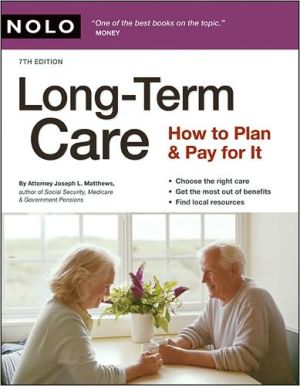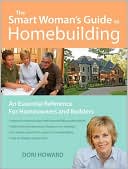Long-Term Care: How to Plan & Pay for It
Get the best care in the right place, for the right price -- this book shows you how! \ Finding the right kind of long-term care often requires making difficult decisions during difficult times. Long-Term Care helps you understand the alternatives to nursing facilities and shows you how to find the best care you can afford.\ With Long-Term Care, you'll be able to:\ *evaluate long-term care insurance\ *arrange home care\ *explore options beyond nursing homes\ *choose a nursing facility\ *get...
Search in google:
Figure out what kind of care you need and how to make it affordable. Modern Maturity Evaluates home health, residential and nursing care facilities, and nursing home insurance; it also looks at Medicare, Medicaid and other benefit programs.
Introduction\ \ All of us have to face the uncomfortable fact that, one day, we or our family members may need some kind of expensive long-term care. Most older people, even if they remain basically healthy, develop physical or mental frailties or impairments that at some point prevent them from living completely independent lives.\ \ More than five million older people in the United States receive some form of daily care at home, provided by someone from outside the family. Millions more receive regular care, though not on a daily basis. And still more millions receive at-home care entirely from family members -- who may not be able to continue that care indefinitely. Nearly two million people over age 65 live full-time in some type of nursing facility or other residential care facility, at a cost of between $30,000 and $150,000 per year. Of people over 65 in nursing facilities, about 15% to 20% will live there for longer than a year and about 8% will live there for more than three years. The average stay for people living in assisted living facilities is about 28 months.\ \ Medicare, which some believe pays for medical care for everyone over 65, in fact pays for only about 10% of all nursing facility costs, a smaller fraction of all home care costs, and nothing at all for long- term care. Medicaid, the federal government program which pays medical costs for the financially needy, pays for about half of all nursing facility costs, but you have to spend most of your personal assets before you become eligible for coverage. And while Medicaid pays for residence in a few assisted living, shelter care, or residential care facilities, most of this cost must be paid with privatefunds.\ \ These statistics convey an urgent, unsettling message: Many of us will need long-term care -- and the government is not going to foot much of the bill. This book can help you prepare for what the future might bring by presenting the alternatives you need to consider. The more physically, emotionally, and financially prepared you are, and the more you are in control of your own life, the better off you and your family will be.\ What Is Long-Term Care?\ \ As used in this book, "long-term care" means regular assistance with medical care (nursing, medicating, physical therapy) or personal needs (eating, dressing, bathing, moving around) provided by someone outside an older person's family. There are many varieties of long-term care -- ranging from part-time home care and adult day care, to independent living and assisted living residential communities, to personal care residences and nursing facilities. Some long-term care is temporary -- for example, just long enough to help an older person recover from a broken hip or a stroke. Often, though, once begun it lasts for the remainder of an older person's life.\ \ Long-Term Care: A Glossary of Terms\ \ Long-term care comes in many varieties and settings. Some types of care are services that can be provided in a senior's own home; others are residential care options. This book covers all of the following types of long-term care in detail. Here we provide brief definitions of various care options, to help you keep the terms straight as you use this book. Bear in mind that most of these are not formal or technical terms -- what people mean when they use these terms may differ slightly from place to place, or from facility to facility.\ \ Adult Day Care: Services such as meals, social activities, and exercise programs, plus companionship, provided for free or low cost at senior centers or special adult day care centers. for seniors who live independently, either at home or with relatives. See "Supplements to Home Care" in Chapter 2.\ \ Assisted Living: Private apartment in a seniors-only residential facility that offers meals, assistance with personal care and housekeeping, and close monitoring of residents' health and safety, but not nursing or other medical care. See "Assisted Living" in Chapter 3.\ \ Board and Care Facility/Home: A long-term care residence facility -- often small, sometimes in a private home -- in which a resident is provided a room (often shared), meals, assistance with personal care, activities, and health and safety monitoring, but not nursing or other medical care. Also called a Residential Care Facility for the Elderly, a Personal Care Facility, or a Sheltered Care Facility. See "Levels of Care" in Chapter 4.\ \ Continuing Care Retirement Community: A multilevel facility which permits a resident to remain in the facility while moving among Independent Living, Assisted Living, and Nursing Facility care, as the resident's needs require. See "Combination Residential Facilities" in Chapter 3.\ \ Convalescent Home: A general term that could describe either a Nursing Facility or a Board and Care or Sheltered Care home. Like "Rest Home," the term is being used less and less.\ \ Custodial Care Facility: Any long-term care residential facility -- including Nursing Facility, Board and Care Home, Residential Care Facility for the Elderly, Personal Care Facility, and Sheltered Care Facility -- in which residents get a private or shared room, meals, assistance with personal care, physical and social activities, and round-the-clock monitoring. Depending on the level of the facility, residents may also receive regular nursing or other medical care. See "Levels of Care" in Chapter 4.\ \ Extended Care Facility: A long-term care residence offering more than one level of care within the same facility. It may combine Independent Living with Assisted Living, assisted Living with a Custodial Care Facility, a Custodial Care Facility with Skilled Nursing Care, or some other combination of these. It does not necessarily offer all levels of care, as a Continuing Care Retirement Community does. See "Combination Residential Facilities" in Chapter 3.\ \ Geriatric Care Manager: Someone who assists in locating and arranging short-term or long-term care for an elder, either at home or in a residential setting. See "Geriatric Care Managers" In Chapter 1.\ \ Home Care/Home Health Care: Short-term or long-term care at a senior's residence. It can include nursing, some medical and therapeutic services, assistance with personal care and the activities of daily life, housekeeping, and meal preparation. Home care can be provided in a private residence or an Independent or Assisted Living Facility, either by a licensed Home Health Care Agency or by individual paid providers. See Chapter 2.\ \ Home Health Care Agency: Certified by each state and by Medicare, these agencies can provide everything from skilled nursing care and therapy to assistance with grocery shopping and personal paperwork. See Chapter 2.\ \ Hospice Care: Hospice is a special type of care, usually provided in the home, for people who are terminally ill and likely to live less than six months. Hospice does not treat the illness but instead focuses on the patient's comfort, particularly pain and other symptom relief. It also provides respite care for primary caregivers. Medicare pays almost the entire cost of hospice care. See Chapter 6.\ \ Independent Living Residence/Community: A building or community specially designed for and restricted to seniors, offering a rented or purchased apartment or house. They provide on-site common facilities and services, but not personal or health care. See "Independent Living" in Chapter 3.\ \ Intermediate Care Nursing Facility: A residential facility that provides some nursing and other medical care, but not as much as a Skilled Nursing Facility provides. These facilities provide long-term care of the chronically ill or disabled, or short-term care until a patient/resident can be moved to a Custodial Care Facility. See "Levels of Care" in Chapter 4.\ \ Long-Term Care: An extended period -- either permanent or during recovery from a serious illness or injury -- of assistance with basic activities of daily living (sometimes called personal care), such as bathing, eating, dressing, and moving around. It includes monitoring of health and safety and may also include nursing care and physical or other therapy, meals, social activities, and housekeeping. Long-term care can be provided in a private home, organized senior residence, or nursing facility.\ \ Long-Term Care Facility: Any of several types of residences designed and operated to provide on-site assistance with basic activities of daily living and to monitor health and safety. See Chapter 4.\ \ Multilevel Facility: Same as Extended Care Facility, above.\ \ Nursing Facility/Home: A residential care facility that provides long-term custodial care. Depending on the type of facility, it may also provide more or less extensive nursing care and physical or other therapy. See Chapter 4.\ \ Personal Care Facility: Same as Board and Care Home, above.\ \ Residential Care Facility for the Elderly (RCFE): Another name for a Personal Care Facility or Board and Care Home.\ \ Respite Care: Temporary, part-time company for a dependent elder intended to give the primary caregiver (usually a spouse or other family member) some time off. See Chapter 2.\ \ Rest Home: An old-fashioned term, not used much any longer, for a Long-Term Care facility.\ \ Senior Residence: A residential building or community that is designed for and limited to seniors. This term is often used to refer to Independent Living or Assisted Living. See Chapter 3.\ \ Sheltered Care: Usually refers to a Board and Care Home (see above) but sometimes refers to Assisted Living (see above).\ \ Skilled Nursing Facility: A residential facility that provides round-the-clock medical monitoring and daily, intensive nursing and therapy, as well as all necessary personal care. Usually limited to short-term stays following serious injury, illness, or surgery. See "Levels of Care" in Chapter 4.\ Threshold Issues of Long-Term Care\ \ An older person's debilitating condition may be only partial -- such as failing hearing or eyesight, memory loss, or weakness in arms or legs. Or it may be extreme -- such as the effects of a major stroke or heart ailment, overall frailty, or the later stages of Alzheimer's disease. Whatever the specific nature of the impairment, you will have to face a number of difficult questions:\ \ * What kind of care is needed?\ * Who will provide it?\ * Where will it be provided?\ * How much will it cost?\ * Who will pay for it?\ \ Attempting to answer these questions will require you to negotiate a number of minefields: Finding the right level and amount of care, avoiding unnecessary institutionalization, understanding complicated Medicare and Medicaid rules, considering private long-term care insurance, and -- importantly -- paying for the high cost of care without losing every cent you have.
Introduction What Is Long-Term Care? Threshold Issues of Long-Term Care 1. Making Decisions About Long-Term Care Getting Started Make a Realistic Family Commitment What Can You Afford? Geriatric Care Managers Other Legal and Financial Matters 2. At-Home Care What Is Home Care? How to Find Home Care Services Provided Kinds of Providers What to Look For Getting Started Costs of Home Care Financing Home Care Through Reverse Mortgages Cashing In a Life Insurance Policy Home Care 3. Organized Senior Residences Independent Living Assisted Living Combination Residential Facilities 4. Long-Term Care Facilities Levels of Care Choosing the Right Facility Your Written Contract 5. Care for Elders With Alzheimer's Disease The Symptoms and Stages of Alzheimer's Home Care for Alzheimer's Residential Care Facilities for Alzheimer's 6. Hospice Care Medicare Eligibility for Hospice Care Services Provided by Hospice How Hospice Operates Payment for Hospice Care 7. Medicare and Veterans' Benefits Medicare Coverage for Long-Term Care Veterans' Benefits for Long-Term Care 8. Medicaid Coverage for Long-Term Care Eligibility for Medicaid What Medicaid Pays For Finding Out About Medicaid in Your State If You Are Denied Medicaid Coverage 9. Medicaid and Asset Protection Medicaid Rules on Transfer of Assets Strategies to Protect Your Assets 10. Protecting Choices About Medical Care and Finances Health Care Decisions Financial Decisions Guardianships and Conservatorships 11. Long-Term Care Insurance Risks and Benefits Warnings About Insurance Practices Extent of Coverage Coverage Conditions and Exclusions Premiums Benefit Amounts Refund Provisions 12. Elder Fraud Why Elders Are Targets Who Commits Elder Fraud Elder Frauds Where to Get Help Appendix: Resource Directory Aging, State Agencies Alzheimer's Disease Organizations Caregiver Support Groups Home Care, Community Programs, and Senior Residences National Organizations State Associations Hospice Organizations State Hospice Organizations Insurance -- Long-Term Care State Departments of Insurance State Agencies on Aging Information About LTC Policies Legal Assistance Licensing and Certification Nursing Facility License and Certification Offices Medicaid Assistance Nursing Facility and Alternative Residence Organizations Ombudsman Offices Reverse Mortgage and Home Equity Conversion Assistance Viatical Settlement Assistance Index
\ Chicago Sun-TimesThis book offers great advice about selecting a nursing home.\ \ \ \ \ Modern MaturityEvaluates home health, residential and nursing care facilities, and nursing home insurance; it also looks at Medicare, Medicaid and other benefit programs.\ \ \ MoneyOne of the best books on the topic.\ \ \ \ \ Chicago Sun-TimesThis book offers great advice about selecting a nursing home.\ — Liz Pulliam Weston\ \ \ \ \ U.S. News & World ReportA straight-talking guide to choosing and paying for a nursing home, assisted living site, or home care.\ — Leonard Wiener\ \ \ \ \ Accounting TodayCovers all the angles, from various kinds of care to evaluating facilities and insurance, to protecting your assets, and even detecting and preventing elder fraud.\ \ \ \ \ Legal Publishing PreviewProvides answers to some of the most difficult questions faced when dealing with how to best care for a senior citizen... should be required reading for anyone who must deal with care options for the elderly.\ \ \ \ \ Modern MaturityEvaluates home health, residential and nursing care facilities, and nursing home insurance; it also looks at Medicare, Medicaid and other benefit programs.\ \ \ \ \ Parent Care AdvisorA practical source of information for families seeking good, affordable care for seniors.\ \ \ \ \ Midwest Book Review"Offers keys to choosing the right long-term care plan to protect assets... this is packed with keys updated to reflect the latest laws and resources, and is a key reference for any general collection."\ \








